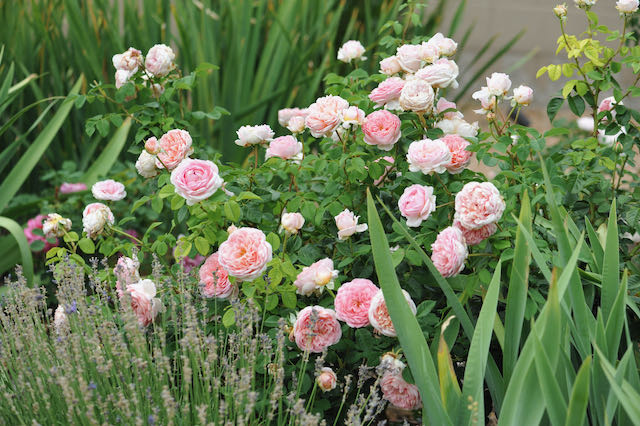On one of the rose forums, this question was posed: What are your Top 10 Most Enjoyable Roses? In thinking about this question, there are a few things I realized. It doesn’t matter how beautiful a rose is if the rest of the package doesn’t satisfy. If the bush only produces a few extraordinarily beautiful roses a year I won’t consider it to be enjoyable. It also doesn’t matter how beautiful a rose is if the bush is ugly. If a bush won’t grow, or is terribly susceptible disease or other problems, if I have to spray it, or try to control how much sun it gets, I won’t enjoy it. On the other hand, if the bush grows beautifully, but the flowers are ugly, there is no point to growing it. So keeping these things in mind, I only came up with three choices.
‘Bishop’s Castle’ isn’t the most beautiful flower. It is a beautiful flower, don’t get me wrong, but I don’t consider it to be one of the most beautiful flowers. What it does have it a nice bush form, strong growth, no disease, minor thrips damage, and nearly constant blooms, which are divinely, waftingly fragrant. It is one of the few roses that blooms for me all summer, through the heat and into the fall. So yes, it is a most enjoyable rose to grow.


If you asked me a year ago, ‘Abraham Darby’ would be very low on my list of roses that are enjoyable to grow. I would have told you that he is an evil witch who has charmed me, and tortured me by withholding his charms despite all my attempts to give him everything he could possibly want. And this, for years. But this year, I think I’ve unlocked that door, and that satisfaction has elevated him to a most enjoyable rose to grow, simply because that challenge is overcome, and is the sweeter for it. This rose is the first Austin that charmed me, and you know what they say about first love. Although a miserable wretch for disease in some climates, that’s one thing he doesn’t get here. I like the form of the bush, the vigor, the size/shape/color/density of thorns. Same for the leaves. He has nice presence in the garden. The flowers great fragrance (even if not wafting like BC). The remaining downside to growing him is the susceptibility of his flowers to thrips.

Similarly, ‘Scentuous’ was a struggle to get going since I got a poor quality plant that was dried out, frozen, or worse. It has been a joy to see it overcome its harsh beginnings, and seems to be happy to grow, and happy to bloom. Although the flowers don’t last long, they come with impressive regularity, and the flowers are simply lovely ruffled confections. The leaves are attractive, the fragrance is always satisfying.
You may notice that there are a number of roses that are not on my list for the “Most Enjoyable Roses” even though they may be some of my most beautiful roses. They might be enjoyable to grow, but not the MOST enjoyable to grow because of certain faults.
‘Desdemona’ has been from the outset, a joy for me to grow. Her growth is mostly constant, as are her blooms. Her growth while vigorous, has been compact, nicely branching and well foliated. There has been no disease. The color of the new growth is red and the mature leaves are a nice color, texture and shape. The flowers politely drop their petals when they fade. The flowers have a most beautiful fragrance. But her flowers are to my eye not the most beautiful, and in fact are a bit disappointing in their size and form whenever I see them, so not the MOST enjoyable.
I still consider ‘Eden’ to be one of the most beautiful roses ever created. But she is extremely susceptible to thrips in my garden, doesn’t rebloom, and doesn’t have a fragrance. ‘Huntington Rose’ is extremely enjoyable to grow because her foliage and bush form are so beautiful. Her flowers are beautiful also. My disappointments with her is that her flowers only last 1-2 days and have only very light fragrance, so I’m debating whether or not to remove her. ‘Radio Times’ may produce some of the most beautiful roses in my garden, and it is becoming more enjoyable to grow. But it has had awkward growth so far, and not the most beautiful bush. ‘Alnwick Castle’ has beautiful flowers, vigorous growth and luscious fragrance. But the bush is stiff, and the flowers only last about 2 days before dropping, and it is not highly productive or reliable.













